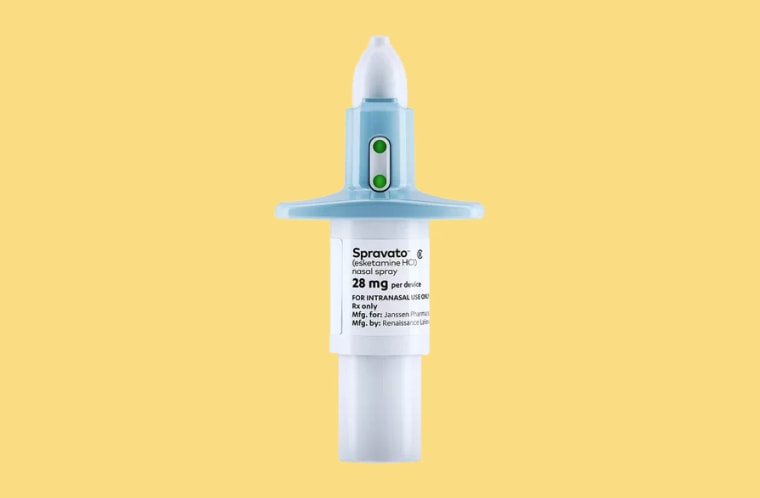A nasal spray version of esketamine was more effective for depression that is resistant to treatment than a more commonly used drug, research published Wednesday in The New England Journal of Medicine found.
Esketamine is a more potent form of ketamine, an anesthetic that doctors have used for many years to treat depression. The nasal spray, from Janssen Pharmaceuticals, is sold under the name Spravato and was approved by the Food and Drug Administration for treatment-resistant depression in 2019. Janssen funded the new study, which took place in 24 countries across Africa, Asia, Europe and South America.
“Treatment-resistant depression is a pretty significant problem,” said Dr. Michael Grunebaum, an associate professor of psychiatry at Columbia University Medical Center in New York City and a research psychiatrist at the New York State Psychiatric Institute.
The condition — commonly defined as depression that does not respond to two or more consecutive drug treatments — is estimated to affect 30% to 50% of people with major depressive disorder, said Grunebaum, who was not involved with the new study but researches ketamine.
In the study, 336 adults with treatment-resistant depression were randomly assigned to receive nasal esketamine in addition to the antidepressant medication they were already taking, either a selective serotonin reuptake inhibitor (SSRI) or a serotonin-norepinephrine reuptake inhibitor (SNRI). Another 340 patients added quetiapine to their drug regimen. Quetiapine is the generic name for Seroquel, an antipsychotic drug that has been on the market since 2007 and is sometimes used to boost the effects of antidepressants in people with treatment-resistant depression.
At the eight-week mark, 27.1% of patients taking esketamine were in remission — meaning they were largely symptom-free — compared to 17.6% of the quetiapine group. By 32 weeks, 21.7% of patients in the esketamine group remained in remission after reaching it at eight weeks compared to 14.1% of those taking quetiapine.
Grunebaum said the results were “quite significant.”
Dr. Allan Young, one of the paper’s authors and an academic psychiatrist at King’s College London, said that while 27.1% may seem small, it’s better than the benchmark: One of the largest and longest U.S. studies of depression, conducted at the beginning of this century, showed 13% of patients with treatment-resistant depression reached remission in response to drugs available at the time, Young said.
And remission in that earlier study didn’t last long, Young added. “They got better, but it was evanescent. They went back to being depressed,” he said.
Still, the rates of remission seen in the esketamine study were low, said Dr. Amit Anand, a professor of psychiatry at Harvard Medical School and a director of translational clinical trials at Brigham and Women’s Hospital in Boston.
“The bottom line is that better treatments need to be developed,” said Anand, who researches ketamine but was not involved with the new paper.
That not all patients who achieved remission at week eight remained in remission by week 32 is not surprising, Grunebaum said. “I wasn’t struck that it seemed radically different from standard antidepressant medications,” he said.
The study also showed that beyond eight weeks, a growing number of patients in both groups continued to reach remission. At week 32, 49.1% of patients in the esketamine group and 32.9% of the patients in the quetiapine group were in remission.
The study had limitations. It compared nasal esketamine to only one other drug. Other drugs used to augment treatment in patients with treatment-resistant depression include low-dose lithium, thyroid medication, atypical antidepressants like bupropion, and pramipexole, a drug used to treat Parkinson’s disease.
In addition, Grunebaum noted that the patients were 90% white, so the results may not apply to people of other races.
Anand said that the method of drug administration may have confounded the results. People receiving nasal esketamine had to come to the hospital two times a week to take the nasal spray in front of health care workers, while those taking quetiapine took a pill at home.
“There is no comparison in the amount of attention given to the patients,” he said. “It’s huge.” That additional attention itself to patients in the esketamine group may have lessened their feelings of depression.
Esketamine’s long-term safety is unknown. Studies of people addicted to ketamine have shown potential injury to brain tissues as well as the lining of the bladder, said Grunebaum, who doesn’t prescribe it in any form to his patients.
“We can usually find a combination of standard medications that work adequately,” he said. “I’m waiting for more information about long-term safety.”
Spravato may be covered by insurance, including Medicare, but doctors have to spend a lot of time documenting treatment-resistant depression, Grunebaum said. Insurance more readily covers other drugs used to augment treatment, many of which are available as generics.
In addition, ketamine is considered a controlled substance in the U.S. because of its potential for abuse and addiction. Patients must take it at a health care provider’s office or clinic. Many may prefer a medication they can take at home.
But Young, the study author, said the visits for the nasal spray are reduced over time, from twice a week in the beginning to a maintenance dose of every two weeks. “I’ve got one patient who takes it once every eight weeks and probably will be able to stop quite soon,” he said.
Follow NBC HEALTH on Twitter & Facebook.

